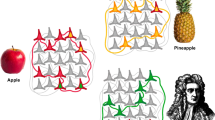Abstract
An essential question about the human learning system is how humans constantly acquire information in an extremely diverse way, successfully store it and constantly retrieve it for ongoing tasks and current needs. While previous artificial intelligence studies have made significant progress in understanding human learning through visual perception, the important role of nonvisual information in building knowledge systems has not been incorporated. In this paper, we propose a theoretical framework. It aims at providing an insight into how nonvisual cues (referred as “discreet cues”) could be incorporated into current neural network architectures. These cues include multisensory information, context, state of mind, and previous experience. When combined with visual cues, they function in different capacities depending on the ongoing task, and are accordingly categorized as passive cues, active cues, and selectively active cues. We propose a hypothetical, theoretical framework that could help take a new step towards accomplishing lifelong human-inspired learning, and assimilation systems that achieve meaningful and powerful computational intelligence.
Access this chapter
Tax calculation will be finalised at checkout
Purchases are for personal use only
Similar content being viewed by others
References
Groff, P.: Research in brief: shapes as cues to word recognition. Visible Lang. 9(1), 67–71 (1975)
Macklin, M.C.: Preschoolers’ learning of brand names from visual cues. J. Consum. Res. 23(3), 251–261 (1996)
Titsworth, B.S., Kiewra, K.A.: Spoken organizational lecture cues and student notetaking as facilitators of student learning. Contemp. Educ. Psychol. 29(4), 447–461 (2004)
Park, S., Lee, J., Kim, S., Shin, D.: The effect of visual cueing in 3D animations for learning procedural-manipulative tasks: from the perspective of cognitive load theory. In: 2016 International Conference on Internet of things and Cloud, pp. 1–4. Association for Computing Machinery, New York (2016)
Gupta, M., Bhilare, P., Katkade, S., Kerkar, U., Thakur, P.: Implementation of artificial intelligence based chatbot system with long term memory. SSRN Online J. SSRN 3574575 (2020)
Nakadai, K., Okuno, H.G.: Robot audition and computational auditory scene analysis. Adv. Intell. Syst. 2(9), 2000050 (2020)
Okuno, H.G., Nakadai, K.: Robot audition: its rise and perspectives. In: 2015 Institute of Electrical and Electronics Engineers (IEEE) International Conference on Acoustics, Speech and Signal Processing (ICASSP), pp. 5610–5614. IEEE, South Brisbane (2015)
Lötsch, J., Kringel, D., Hummel, T.: Machine learning in human olfactory research. Chem. Senses 44(1), 11–22 (2019)
Campos, J.L., Butler, J.S., Mohler, B.J., Bülthoff, H.H.: The contributions of visual flow and locomotor cues to walked distance estimation in a virtual environment. In: Proceedings of the 4th Symposium on Applied Perception in Graphics and Visualization, p. 146. Association for Computing Machinery, New York (2007)
Peters, B., Kriegeskorte, N.: Capturing the objects of vision with neural networks. Nat. Hum. Behav. 5, 1127–1144 (2021)
Stepankov, V.Y., Dushkin, R.V.: Hierarchical associative memory model for artificial general-purpose cognitive agents. Proc. Comput. Sci. 190, 723–727 (2021)
Parisi, G.I., Kemker, R., Part, J.L., Kanan, C., Wermter, S.: Continual lifelong learning with neural networks: a review. Neural Netw. 113, 54–71 (2019)
Irfan, M., Zheng, J., Iqbal, M., Masood, Z., Arif, M., Hassan, S.: Brain inspired lifelong learning model based on neural based learning classifier system for underwater data classification. Expert Syst. Appl. 186 (2021)
Phan, H., Andreotti, F., Cooray, N., Chen, O.Y., De Vos, M.: Joint classification and prediction CNN framework for automatic sleep stage classification. IEEE Trans. Biomed. Eng. 66(5), 1285–1296 (2019)
Stiver, J., Fusco-Gessick, B., Moran, E., Crook, C., Zimmerman, M.: Variable objective sleep quality is related to worse spatial learning and memory in young adults. Sleep Med. 84, 114–120 (2021)
Weiss, K., Khoshgoftaar, T.M., Wang, D.: A survey of transfer learning. J. Big Data 3(1), 1–40 (2016). https://doi.org/10.1186/s40537-016-0043-6
Preston, A.R., Eichenbaum, H.: Interplay of hippocampus and prefrontal cortex in memory. Curr. Biol. 23(17), 764–773 (2013)
Watling, C., Driessen, E., van der Vleuten, C.P., Lingard, L.: Learning from clinical work: the roles of learning cues and credibility judgements. Med. Educ. 46(2), 192–200 (2012)
Barceló, J.A., De Almeida, V.M.: Functional analysis from visual and non-visual data. An artificial intelligence approach. Mediterr. Archaeol. Archaeom. 12(2), 273–321 (2012)
Kaestner, E.J., Wixted, J.T., Mednick, S.C.: Pharmacologically increasing sleep spindles enhances recognition for negative and high-arousal memories. J. Cogn. Neurosci. 25(10), 1597–1610 (2013)
Cardoso, L.R.L., Umemura, G.S., Pedro, L.M., Forner-Cordero, A.: Sleep restriction effects on a robotic guided motor task. In: 8th IEEE RAS/EMBS International Conference for Biomedical Robotics and Biomechatronics (BioRob), pp. 218–222. IEEE, South Brisbane (2020)
McClelland, J.L., McNaughton, B.L., O’Reilly, R.C.: Why there are complementary learning systems in the hippocampus and neocortex: insights from the successes and failures of connectionist models of learning and memory. Psychol. Rev. 102, 419–457 (1995)
Winocur, G., Moscovitch, M., Bontempi, B.: Memory formation and long-term retention in humans and animals: convergence towards a transformation account of hippocampal-neocortical interactions. Neuropsychologia 48(8), 2339–2356 (2010)
Norman, K.A., Newman, E.L., Perotte, A.J.: Methods for reducing interference in the complementary learning systems model: oscillating inhibition and autonomous memory rehearsal. Neural Netw. 18(9), 1212–1228 (2005)
Gepperth, A., Karaoguz, C.: A bio-inspired incremental learning architecture for applied perceptual problems. Cogn. Comput. 8(5), 924–934 (2016)
Acknowledgment
We would like to express our sincere gratitude to our professor Dr. Monica Lopez-Gonzalez for her endless encouragement and insightful discussions which helped guide our thoughts throughout this work.
Author information
Authors and Affiliations
Corresponding author
Editor information
Editors and Affiliations
Rights and permissions
Copyright information
© 2023 The Author(s), under exclusive license to Springer Nature Switzerland AG
About this paper
Cite this paper
Seth, A., Guo, W. (2023). Proposing Theoretical Frameworks for Including Discreet Cues and Sleep Phases in Computational Intelligence. In: Arai, K. (eds) Intelligent Systems and Applications. IntelliSys 2022. Lecture Notes in Networks and Systems, vol 544. Springer, Cham. https://doi.org/10.1007/978-3-031-16075-2_49
Download citation
DOI: https://doi.org/10.1007/978-3-031-16075-2_49
Published:
Publisher Name: Springer, Cham
Print ISBN: 978-3-031-16074-5
Online ISBN: 978-3-031-16075-2
eBook Packages: Intelligent Technologies and RoboticsIntelligent Technologies and Robotics (R0)




